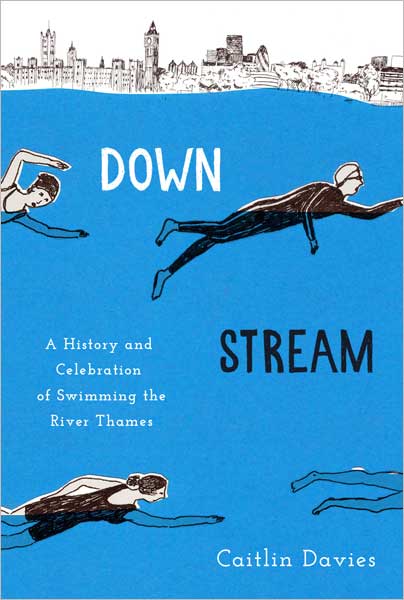Down Stream: A History and Celebration of Swimming the River Thames
(Aurum Press) by Caitlin Davies
Review by Tim Sutton:
I have always lived in London, and rather taken the Thames for granted. To me it brings thoughts of dark dirty water, thrashing propellors and Dickensian drownings, so it is not somewhere I would consider swimming. So to be asked to review a book about Swimming in its murky waters certainly raised my curiosity.
The author, Caitlin Davies, starts her journey at Trewsbury Mead, the sometimes disputed Head of the Thames, and finishes at the Crowstone marker at the end of the Thames estuary. What surprised me most was the amount of swimming that actually took place on the river, and the famous people who have swam there including Charles II, Lord Byron, Charles Dickens, Benjamin Franklin, Bamber Gascoigne, Matthew Paris, Steven Berkofff and most recently David Walliams.

But it is the stories of forgotten Victorian heroes, and their record breaking swims, which most impress. There was Lily Smith who swam in order ‘to put a stop forever to all this twaddle about the weaker sex’ , Captain Boyton ‘the Fearless Frogman’ and his inflatable rubber suit and Mercedes Glietz ‘the London Typist’ who escaped certain death after being sucked under a barge at Wapping. In 1878 the Mayor of Greenwich declared that ‘only one in fifty’ waterman knew how to swim, so these exhibition swims helped publicise the new ‘art’ and ‘science’ of swimming, including strokes such as the ‘trudgeon’, ‘half back, half side’ and ‘right arm over’.
As well as these epic swims, Caitlin also re-visits many swimming spots that used to dot the banks of the Thames including Putney Beach, the Floating Baths at Pimlico, the Royal Waterloo Bath, Tower Bridge Beach, Grays ‘Pond’ and the Gravesend Bathing Establishment, with accompanying stories of segregated swimming and bathing machines.
There was also the question of suitable attire, which for men in the early days seemed to be ‘nothing at all’ (pleasure boat passengers were often shocked by the site of naked young men on the banks). For women things were more complicated, such as Agnes Beckwith who in 1875 dived into the Thames wearing ‘a swimming costume of light rose pink llama trimmed with white braid and lace of the same colour’.
Caitlin also describes the many galas and races such as the Surrey Ladies ‘Annual Entertainment’, the ‘Lords and Commons Race’ at Kew, the ‘Putney to Hammersmith’ mile and the annual ‘Millwall Cutting’ open air gala, where competitors would be rewarded with prizes of a ‘shaving set’ or ‘tête-à-tête tea service’. However, come the start of the century all this activity starts to fade, probably caused by the outbreak of war, the building of indoor public baths and increased pollution in the Thames. Somehow we seemed to get out of the habit of swimming in our river.
But things are now changing. The River Thames is now the cleanest it has been for 200 years with fish and wild-life, including the Harbour Porpoise, returning to its waters. Swimming clubs, such at the Thames Otters, have survived and are again flourishing. Once forgotten races, like the ‘Long Run’ in Maidenhead have been re-born and new races including the ‘Great River Swim’ in Chiswick, the Henley Mile, the ‘Great London Swim’ in Docklands and the ‘Crowstone Crawl’ draw ever increasing numbers. We also have the new floating Thames Baths to look forward to, as well as cleaner water when the Thames Super Sewer is completed in 2023.
The Thames can be a dangerous place (an average of 35 to 45 people drown in the Thames in Central London every year) but maybe this has been allowed to over-shadow its former glories as a place to swim. Caitlin’s book has certainly inspired me to think outside the comforts of my daily swim at the Lido. Perhaps this summer I may also go Down Stream, as long as I can avoid those pesky territorial swans.

